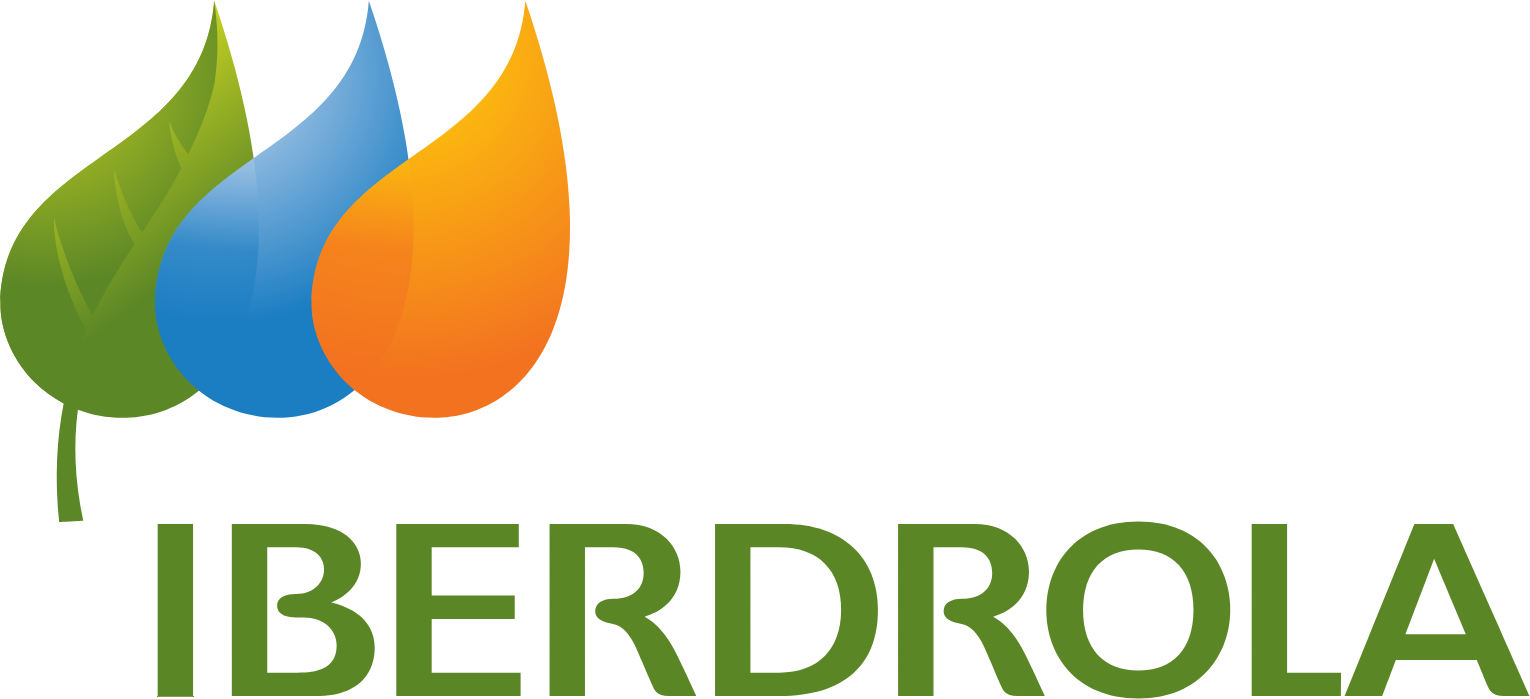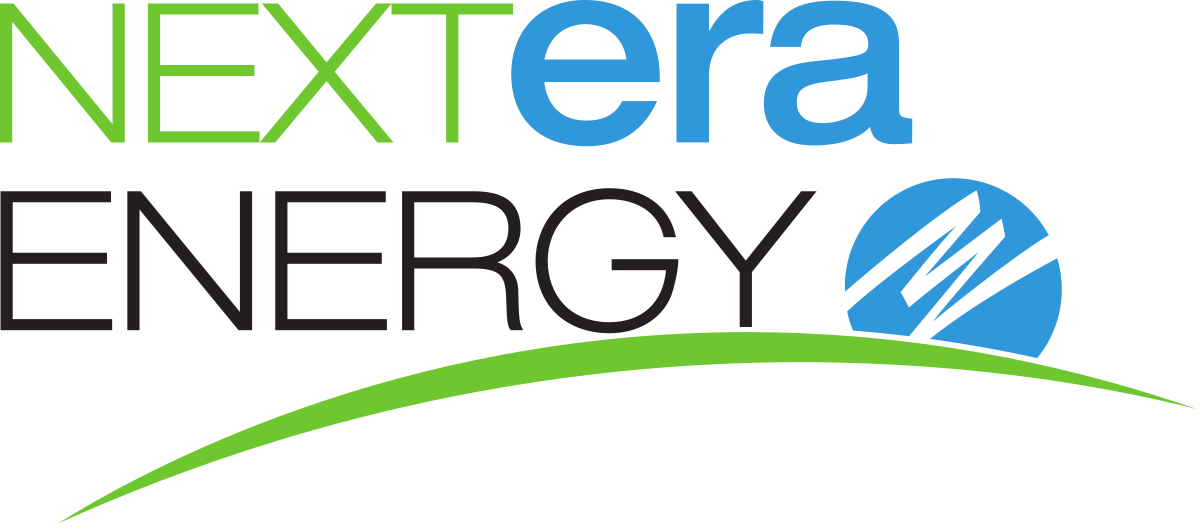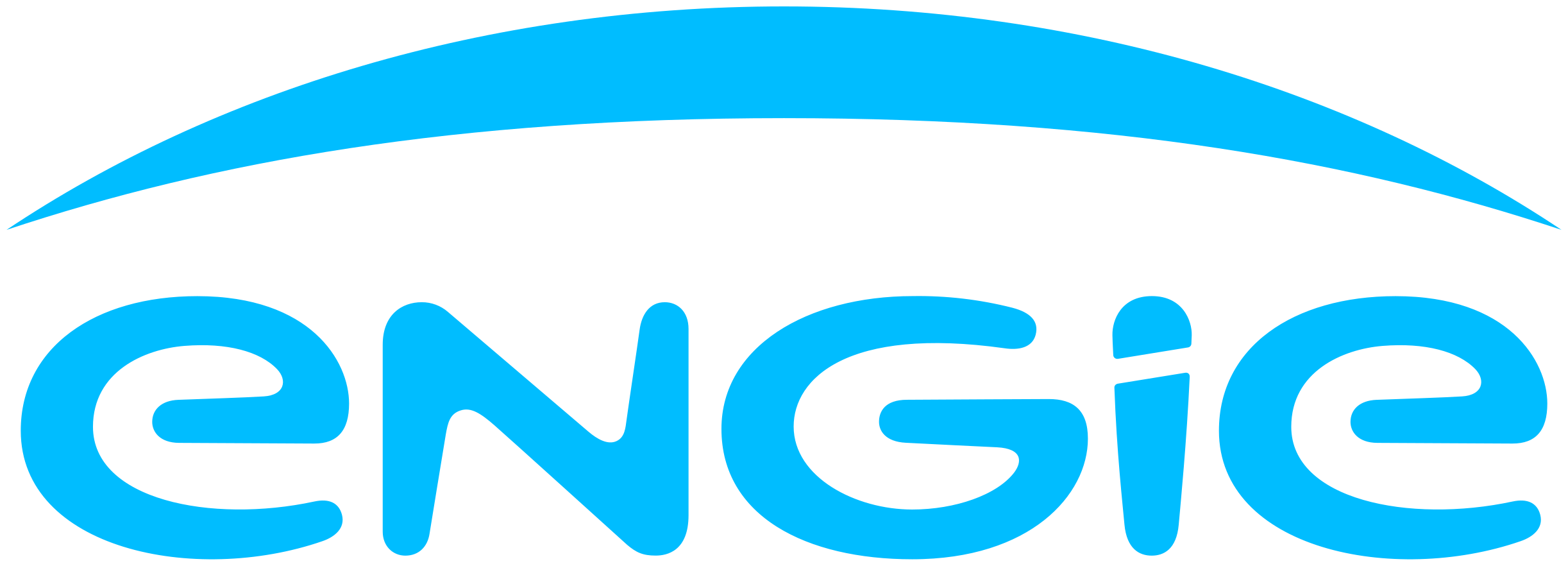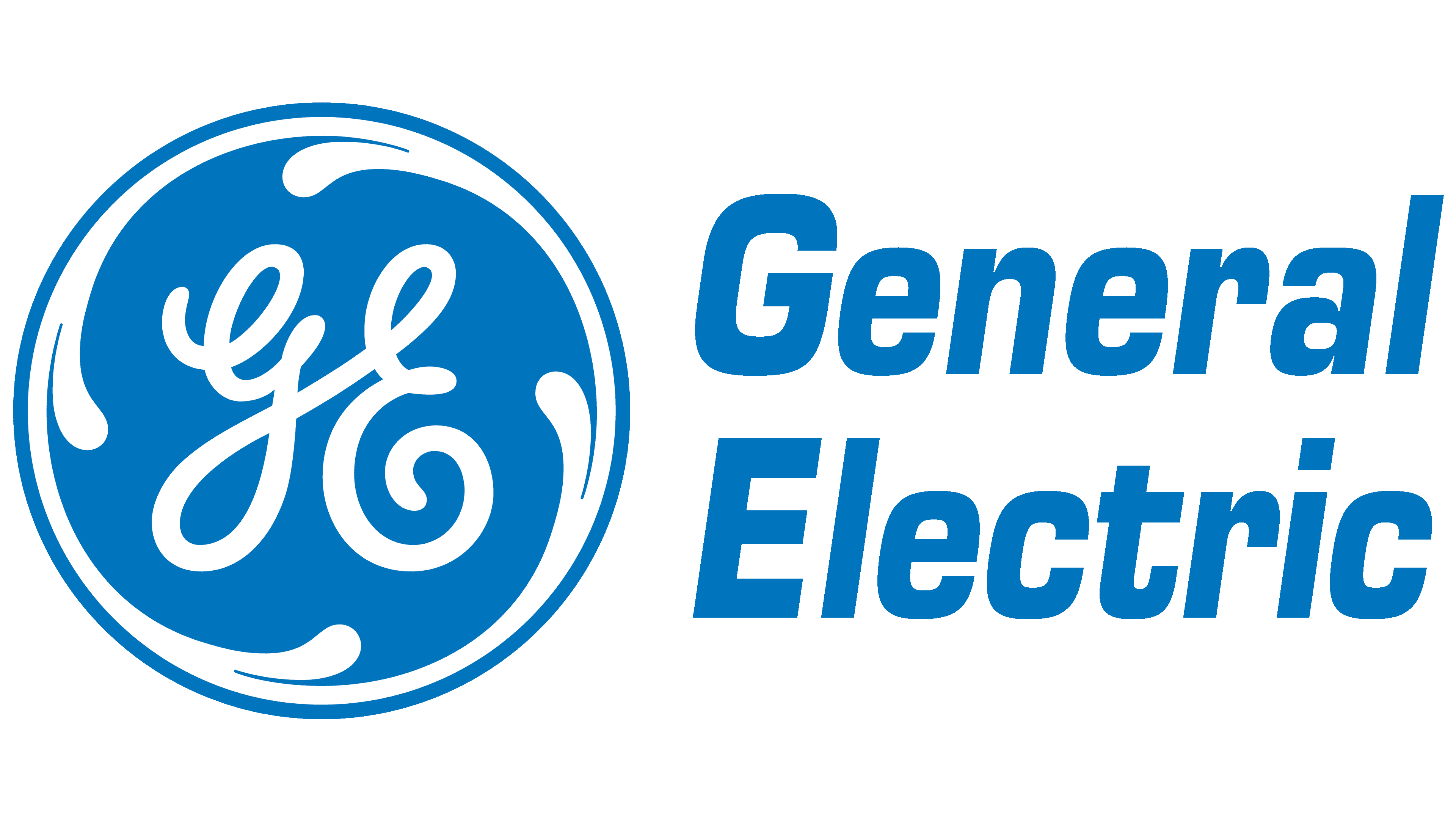Global Hydrogen Compressors Market: By Type, By Lubrication Type, By Design, By End-User, By Region & Segmental Insights Trends and Forecast, 2024 – 2034
- Industry: Energy & Power
- Report ID: TNR-110-1109
- Number of Pages: 420
- Table/Charts : Yes
- May, 2024
- Base Year : 2024
- No. of Companies : 10+
- No. of Countries : 29
- Views : 10178
- Covid Impact Covered: Yes
- War Impact Covered: Yes
- Formats : PDF, Excel, PPT
Hydrogen compressors are specialized devices designed to increase the pressure of hydrogen gas for various industrial and commercial applications. These compressors are crucial in sectors such as energy storage, fuel cell technology, hydrogen refuelling stations, and chemical manufacturing. They work by reducing the volume of hydrogen, thereby increasing its pressure, making it easier to store, transport, and utilize efficiently. Types of hydrogen compressors include diaphragm, piston, reciprocating, rotary, and electrochemical compressors, each suited to specific purity and pressure requirements. The growing emphasis on hydrogen as a clean energy source drives the demand for reliable and efficient hydrogen compressors, essential for ensuring the safe and effective handling of hydrogen in both production and end-use applications.
The demands for hydrogen compressor is primarily driven by the growing adoption of hydrogen as a clean energy source, particularly in fuel cell technology and hydrogen refuelling stations. This rise in demand presents significant opportunities, such as advancements in renewable energy integration, increased investment in hydrogen infrastructure, and the expansion of green hydrogen production.
However, the sector faces notable challenges, including the need for compressors that can handle high pressures and purity requirements efficiently. Additionally, the high cost of advanced compressor technologies and the technical difficulties in maintaining performance and safety standards pose significant hurdles. Despite these challenges, ongoing technological innovations and the global push towards sustainable energy solutions are likely to foster further development and adoption of hydrogen compressors.
In terms of revenue, the global hydrogen compressors market was worth US$ 2.2 Bn in 2023, anticipated to witness CAGR of 5.2% During 2024 – 2034.
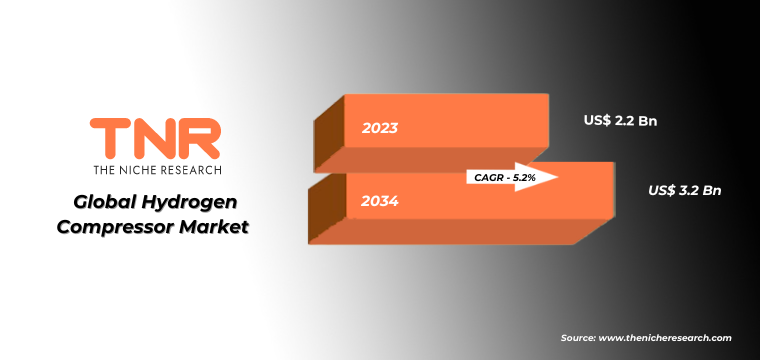
Global Hydrogen Compressors Market Dynamics
Clean Energy Transition: The shift towards renewable energy sources and the reduction of carbon emissions drives the demand for hydrogen compressors as hydrogen is increasingly used as a clean energy carrier. Growing adoption of hydrogen fuel cells in transportation and industrial applications boosts the need for reliable hydrogen compression.
Government Policies: Supportive government policies and incentives promoting hydrogen infrastructure development enhance market demand. Increased use of hydrogen in chemical manufacturing, metal refining, and other industrial processes contributes to the rising demand for hydrogen compressors.
Technological Advancements: Innovations in compressor design and materials improve efficiency and reduce costs, creating growth opportunities. The development of hydrogen refuelling stations and storage facilities expands the market for hydrogen compressors. Advances in electrolysis and other green hydrogen production methods necessitate efficient compression solutions.
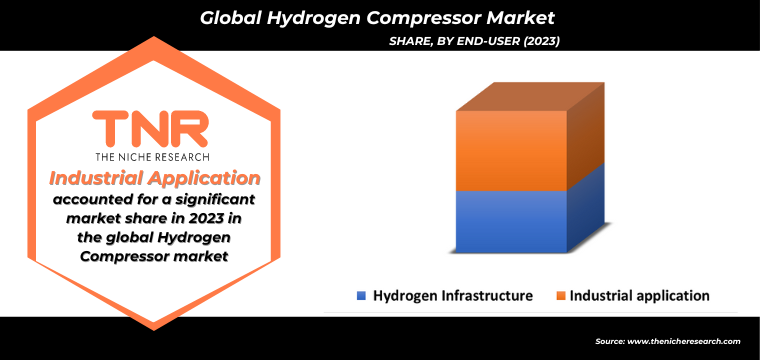
Single Stage Hydrogen Compressors Has garnered major market share in the Global Hydrogen Compressors Market During the Forecast Period (2024 – 2034).
Single-stage hydrogen compressors are essential in various applications where moderate pressure levels are required. These compressors are in demand due to the growing use of hydrogen in industrial processes and energy storage. Key demand drivers include the increasing adoption of hydrogen as a clean energy source and the expansion of hydrogen refuelling stations for fuel cell vehicles. The simplicity and cost-effectiveness of single-stage compressors make them attractive for applications requiring efficient compression at moderate pressures. Opportunities in this market arise from advancements in hydrogen production technologies, such as electrolysis, which require reliable compression solutions.
The ongoing development of hydrogen infrastructure, including refuelling stations and storage facilities, further boosts the demand for single-stage compressors. Additionally, innovations in compressor design and materials can enhance efficiency and reduce operational costs, making these systems more appealing. However, challenges persist, such as the need to handle hydrogen safely due to its highly flammable nature. Ensuring the durability and reliability of compressors while maintaining cost-effectiveness is critical. Addressing these challenges through technological advancements and robust safety protocols is essential for the sustained growth of the single-stage hydrogen compressor market.

By Type Mechanical Hydrogen Compressor Segment had the Highest Share in the Global Hydrogen Compressors Market in 2023.
Mechanical hydrogen compressors are pivotal for various applications requiring hydrogen gas at elevated pressures, such as energy storage, fuel cell vehicles, and industrial processes. Demand drivers for these compressors include the rapid expansion of the hydrogen economy as industries shift towards cleaner energy sources. The increasing adoption of hydrogen fuel cells in transportation and the growing network of hydrogen refuelling stations significantly boost the need for reliable hydrogen compression solutions.
Additionally, hydrogen’s role in decarbonizing industrial processes, such as ammonia production and steel manufacturing, further fuels this demand. Opportunities in the mechanical hydrogen compressor market are vast, driven by advancements in green hydrogen production technologies like electrolysis, which necessitate efficient and robust compression systems. Innovations in compressor design, aiming to enhance efficiency and reduce operational costs, present significant growth potential. Furthermore, expanding hydrogen infrastructure globally creates new avenues for market development.

By Lubricant Type Oil-Free Segment had the Highest Share in the Global Hydrogen Compressors Market in 2023.
Oil-free hydrogen compressors are increasingly in demand due to their ability to maintain high-purity hydrogen, essential for sensitive applications such as fuel cells, electronics, and pharmaceuticals. Key demand drivers include the rapid expansion of the hydrogen economy and the growing network of hydrogen refuelling stations, where contamination-free hydrogen is crucial. Stricter environmental regulations and industry standards also favor oil-free compressors for their cleaner operation and reduced risk of contaminating the hydrogen stream. Additionally, advancements in green hydrogen production technologies, like electrolysis, which require pure hydrogen, further boost the demand. The need for reliable, low-maintenance, and efficient hydrogen compression solutions makes oil-free compressors a preferred choice in various high-purity applications.

In 2023, demand for hydrogen compressors market across Asia Pacific has gained significant prominence, being driven by several factors.
Firstly, the region is experiencing rapid industrialization and urbanization, leading to increased energy consumption and a greater focus on clean energy solutions like hydrogen. Government initiatives promoting hydrogen as a key component of their energy transition strategies further boost demand. Additionally, the growing adoption of hydrogen fuel cells in transportation, particularly in countries like Japan and South Korea, fuels the need for reliable compression infrastructure. Furthermore, advancements in green hydrogen production technologies, driven by countries’ commitments to reduce carbon emissions, create opportunities for hydrogen compressor manufacturers. As the Asia-Pacific region emerges as a key player in the global hydrogen economy, the demand for compressors to support hydrogen infrastructure development is expected to continue to rise.
Competitive Landscape: Global Hydrogen Compressors Market:
- Atlas Copco AB
- Cook Compression
- HIPERBARIC
- Hoerbiger
- Howden Group
- Hycomp Inc
- Ingersoll Rand
- Mehrer Compression GmbH
- Mitsubishi Power
- Neuman & Esser Group
- Pure Energy Centre
- Siemens
- Sundyne
- Other Industry Participants
Global Hydrogen Compressors Market: Key Data Points
| Report Specifications | Details |
| Market Revenue in 2023 | US$ 2.2 Bn |
| Market Size Forecast by 2034 | US$ 3.2 Bn |
| Growth Rate (CAGR) | 5.2% |
| Historic Data | 2016 – 2022 |
| Base Year for Estimation | 2023 |
| Forecast Period | 2024 – 2034 |
| Report Inclusions | Market Size & Estimates, Market Dynamics, Competitive Scenario, Trends, Growth Factors, Market Determinants, Key Investment Segmentation, Product/Service/Solutions Benchmarking |
| Segments Covered | By Type, By Lubrication Type, By Design, By End-User |
| Regions Covered | North America, Europe, Asia Pacific, Middle East & Africa, Latin America |
| Countries Covered | U.S., Canada, Mexico, Rest of North America, France, The UK, Spain, Germany, Italy, Nordic Countries (Denmark, Finland, Iceland, Sweden, Norway), Benelux Union (Belgium, The Netherlands, Luxembourg), Rest of Europe, China, Japan, India, New Zealand, Australia, South Korea, Southeast Asia (Indonesia, Thailand, Malaysia, Singapore, Rest of Southeast Asia), Rest of Asia Pacific, Saudi Arabia, UAE, Egypt, Kuwait, South Africa, Rest of Middle East & Africa, Brazil, Argentina, Rest of Latin America |
| Key Players | Atlas Copco AB, Cook Compression, HIPERBARIC, Hoerbiger, Howden Group, Hycomp Inc, Ingersoll Rand, Mehrer Compression GmbH, Mitsubishi Power, Neuman & Esser Group, Pure Energy Centre, Siemens, Sundyne, Other Industry Participants |
| Customization Scope | Customization allows for the inclusion/modification of content pertaining to geographical regions, countries, and specific market segments. |
| Pricing & Procurement Options | Explore purchase options tailored to your specific research requirements |
| Contact Details | Consult With Our Expert
Japan (Toll-Free): +81 663-386-8111 South Korea (Toll-Free): +82-808- 703-126 Saudi Arabia (Toll-Free): +966 800-850-1643 United Kingdom: +44 753-710-5080 United States: +1 302-232-5106 E-mail: askanexpert@thenicheresearch.com
|
Global Hydrogen Compressors Market
By Type
- Mechanical Compressor
- Non-Mechanical Compressor
By Lubrication Type
- Oil-based
- Oil-free
By Design
- Single-stage
- Multi-stage
By End-User
- Hydrogen Infrastructure
- Hydrogen storage & transportation
- Hydrogen refueling stations
- Industrial application
- Oil refining
- Chemicals & Petrochemicals
- Others
By Region
- North America (U.S., Canada, Mexico, Rest of North America)
- Europe (France, The UK, Spain, Germany, Italy, Nordic Countries (Denmark, Finland, Iceland, Sweden, Norway), Benelux Union (Belgium, The Netherlands, Luxembourg), Rest of Europe)
- Asia Pacific (China, Japan, India, New Zealand, Australia, South Korea, Southeast Asia (Indonesia, Thailand, Malaysia, Singapore, Rest of Southeast Asia), Rest of Asia Pacific)
- Middle East & Africa (Saudi Arabia, UAE, Egypt, Kuwait, South Africa, Rest of Middle East & Africa)
- Latin America (Brazil, Argentina, Rest of Latin America)
Report Layouts:
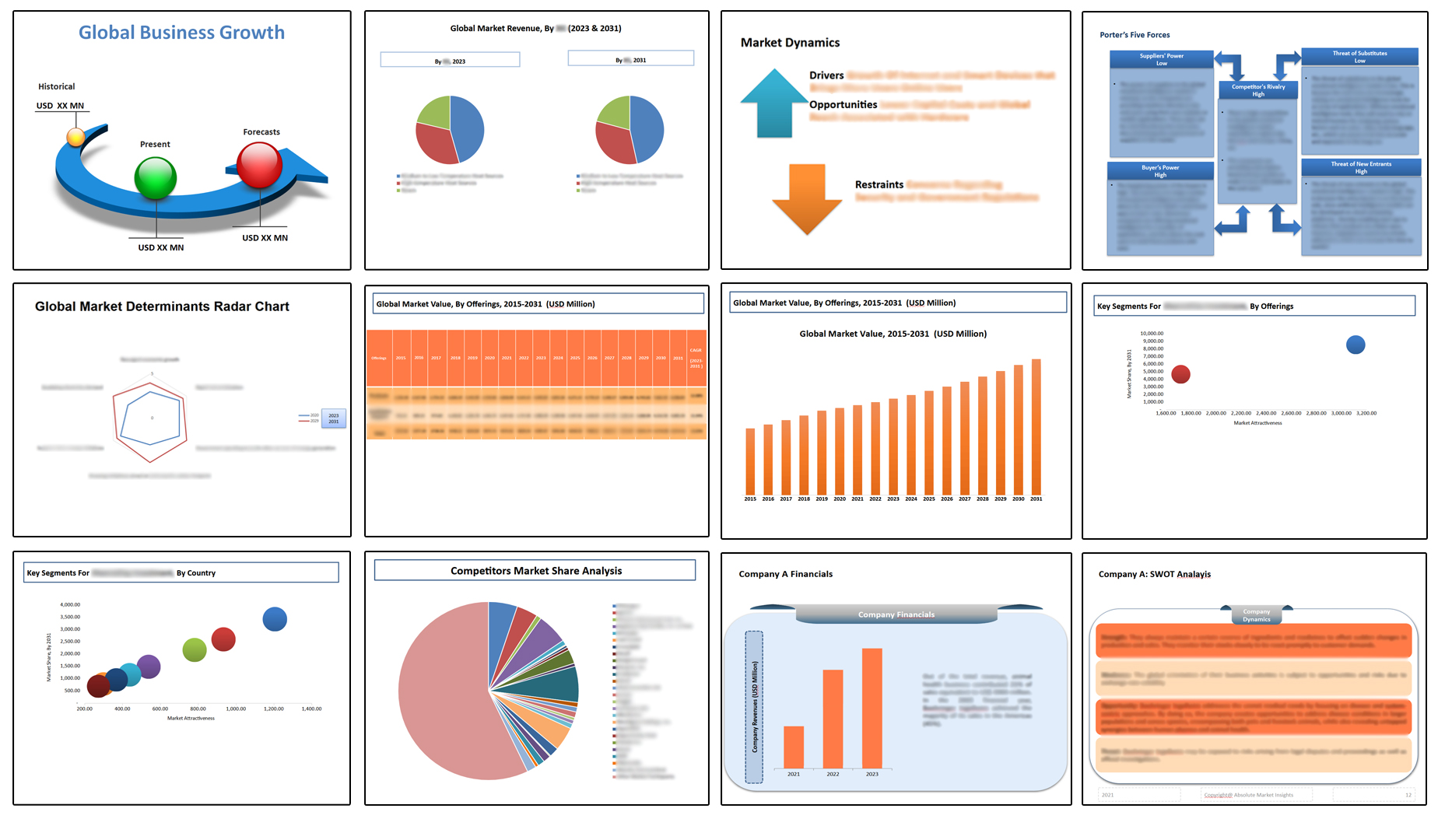
Table of Contents
**Exclusive for Multi-User and Enterprise User.
Global Hydrogen Compressors Market
By Type
- Mechanical Compressor
- Non-Mechanical Compressor
By Lubrication Type
- Oil-based
- Oil-free
By Design
- Single-stage
- Multi-stage
By End-User
- Hydrogen Infrastructure
- Hydrogen storage & transportation
- Hydrogen refueling stations
- Industrial application
- Oil refining
- Chemicals & Petrochemicals
- Others
By Region
- North America (U.S., Canada, Mexico, Rest of North America)
- Europe (France, The UK, Spain, Germany, Italy, Nordic Countries (Denmark, Finland, Iceland, Sweden, Norway), Benelux Union (Belgium, The Netherlands, Luxembourg), Rest of Europe)
- Asia Pacific (China, Japan, India, New Zealand, Australia, South Korea, Southeast Asia (Indonesia, Thailand, Malaysia, Singapore, Rest of Southeast Asia), Rest of Asia Pacific)
- Middle East & Africa (Saudi Arabia, UAE, Egypt, Kuwait, South Africa, Rest of Middle East & Africa)
- Latin America (Brazil, Argentina, Rest of Latin America)
The Niche Research approach encompasses both primary and secondary research methods to provide comprehensive insights. While primary research is the cornerstone of our studies, we also incorporate secondary research sources such as company annual reports, premium industry databases, press releases, industry journals, and white papers.
Within our primary research, we actively engage with various industry stakeholders, conducting paid interviews and surveys. Our meticulous analysis extends to every market participant in major countries, allowing us to thoroughly examine their portfolios, calculate market shares, and segment revenues.
Our data collection primarily focuses on individual countries within our research scope, enabling us to estimate regional market sizes. Typically, we employ a bottom-up approach, meticulously tracking trends in different countries. We analyze growth drivers, constraints, technological innovations, and opportunities for each country, ultimately arriving at regional figures.Our process begins by examining the growth prospects of each country. Building upon these insights, we project growth and trends for the entire region. Finally, we utilize our proprietary model to refine estimations and forecasts.
Our data validation standards are integral to ensuring the reliability and accuracy of our research findings. Here’s a breakdown of our data validation processes and the stakeholders we engage with during our primary research:
- Supply Side Analysis: We initiate a supply side analysis by directly contacting market participants, through telephonic interviews and questionnaires containing both open-ended and close-ended questions. We gather information on their portfolios, segment revenues, developments, and growth strategies.
- Demand Side Analysis: To gain insights into adoption trends and consumer preferences, we reach out to target customers and users (non-vendors). This information forms a vital part of the qualitative analysis section of our reports, covering market dynamics, adoption trends, consumer behavior, spending patterns, and other related aspects.
- Consultant Insights: We tap into the expertise of our partner consultants from around the world to obtain their unique viewpoints and perspectives. Their insights contribute to a well-rounded understanding of the markets under investigation.
- In-House Validation: To ensure data accuracy and reliability, we conduct cross-validation of data points and information through our in-house team of consultants and utilize advanced data modeling tools for thorough verification.
The forecasts we provide are based on a comprehensive assessment of various factors, including:
- Market Trends and Past Performance (Last Five Years): We accurately analyze market trends and performance data from preceding five years to identify historical patterns and understand the market’s evolution.
- Historical Performance and Growth of Market Participants: We assess the historical performance and growth trajectories of key market participants. This analysis provides insights into the competitive landscape and individual company strategies.
- Market Determinants Impact Analysis (Next Eight Years): We conduct a rigorous analysis of the factors that are projected to influence the market over the next eight years. This includes assessing both internal and external determinants that can shape market dynamics.
- Drivers and Challenges for the Forecast Period:Identify the factors expected to drive market growth during the forecast period, as well as the challenges that the industry may face. This analysis aids in deriving an accurate growth rate projection.
- New Acquisitions, Collaborations, or Partnerships: We keep a close watch on any new acquisitions, collaborations, or partnerships within the industry. These developments can have a significant impact on market dynamics and competitiveness.
- Macro and Micro Factors Analysis:A thorough examination of both macro-level factors (e.g., economic trends, regulatory changes) and micro-level factors (e.g., technological advancements, consumer preferences) that may influence the market during the forecast period.
- End-User Sentiment Analysis: To understand the market from the end-user perspective, we conduct sentiment analysis. This involves assessing the sentiment, preferences, and feedback of the end-users, which can provide valuable insights into market trends.
- Perspective of Primary Participants: Insights gathered directly from primary research participants play a crucial role in shaping our forecasts. Their perspectives and experiences provide valuable qualitative data.
- Year-on-Year Growth Trend: We utilize a year-on-year growth trend based on historical market growth and expected future trends. This helps in formulating our growth projections, aligning them with the market’s historical performance.
Research process adopted by TNR involves multiple stages, including data collection, validation, quality checks, and presentation. It’s crucial that the data and information we provide add value to your existing market understanding and expertise. We have also established partnerships with business consulting, research, and survey organizations across regions and globally to collaborate on regional analysis and data validation, ensuring the highest level of accuracy and reliability in our reports.
